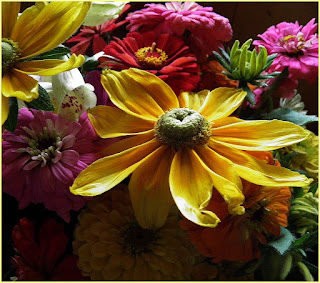Monday, June 5, 2017
A dark morning here at the flower farm. Light rain continues after a night of fairly constant rain. The fact is, we don't need any more rain here in Vermont. In fact farmers--all farmers--any kind of farmers--including me--are tired of rain. We cannot get on the fields and if we think we can, we only create more problems for ourselves. With each passing day I tell myself it will be better tomorrow but so far the only plants that have been doing well are the hostas and they have never looked so good. Rain of course, is the very best fertilizer for hostas!
Last summer I was invited to write a monthly gardening piece for The North Star Monthly, a Danville, Vermont newspaper that was originally established in 1807 and re-established in 1989. I agreed to the opportunity and continue on. I usually publish what I have written some months later so here are some winter postings that might interest you beginning back with the March Issue when I offered a few thoughts about wedding plans.
WEDDING PLANS
It’s a cold 10.2° here on the mountain this morning. The woodstove is blazing which is great because today is the day the power company turned off the electricity for some repair work. The birds of the forests arrived late at our feeders but came in abundance and there are some we have not seen in days that made the journey. Our one pair of cardinals is included with +20 mourning doves, 13 blue jays and 17 mourning doves, white and red breasted nuthatches, chickadees by the dozens and a pair of creepers which have never visited before. The snow has reached the level that the perennial flowers such as echinacea, liatris, helenium and rudbeckia that we leave as winter bird food are now covered so the feeders increase in importance. Watching these birds is a fun hobby and a good fill-in for gardeners longing for garden color but seeing only white.
So as birds come to the flower farm looking for food, the phone rings and emails register with inquiries about flowers for summer weddings, graduations and special events. Some days we feel as if everyone wakes up and asks “The flowers, who took care of the flowers?” In the depth of our Vermont winter, I raise the topic because flowers--which seem like such an easy part of any event, are complicated and not that “let’s throw it together at the last minute” chore.
Probably the biggest challenge for a flower farmer is dealing with what the customer does not know. Flowers for any event are not a “pick them, put them in a vase, throw them out when they go by” kind of labor. It requires planning, picking ahead of time to harden the stems off, and floral skills to make them look close to your expectation. Forget about flowers in a vase, did you ever make a hand carry, a corsage, a boutonniere or the myriad other configurations that look so nice in wedding magazines or on catering websites but are tricky to make, especially in quantity.
We find that flowers go beyond the creative skills piece and actually must begin with knowledge of the flowers that are appealing to the customer. For example, you probably have no idea how many people call us requesting peonies. They might say they want peonies, lots and lots of peonies and they want them in September for a fall wedding. There’s no doubt about it that peonies are a wonderful flower but by mid July in Vermont, peonies have finished blooming for the year. That’s just a reality. Yes, a florist could find them for you but they would be shipped in from Alaska where the season is still going…and the per stem price tag would be a whopping $11-$14 a stem plus freight and would come with serious minimum numbers. So the message here is you have to know your flowers, know their availability and also know their care. They look nice in the garden, but will they look nice later? Can you obtain the colors you want in the numbers you need in the bloom or stem size that you are thinking of? These are all things that require some planning.
People quite often arrive at the farm and tell us someone is getting married today or tomorrow and can they walk around and pick some flowers. Sorry, but “No”. We do not offer pick your own flowers because there is more to it than meets the eye. Flowers must be picked early in the morning or late in the day and morning is best. Not morning at 11 o’clock but morning at 6 o’clock. Some flowers can be picked and hand carried out of the field but most need to go right into a bucket of water, sometimes with preservative, sometimes not. The timing on this is critical so the flowers maintain good turgidity and hold up well when arranged.
So-o-o-o the message from this flower farmer is to think about our comments and plan now for those special summer and fall events that involve cut or potted flowers. Gail and I are happy to answer your questions and steer you towards some resources. Beautiful flowers will make a memorable event that much more memorable …….. just plan ahead……please!
Questions? Reach us at:
802-426-3505
verontflowerfarm@outlook.com




























